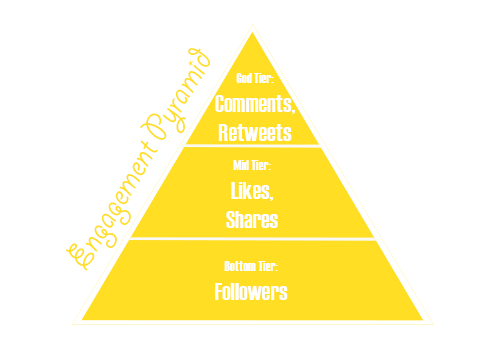When I worked in PR for a hot minute, we would typically scout influencers to work with a brand by looking at a user’s content and engagement rate. An engagement rate is reflected by the number of likes and comments a user gets in ratio to the number of followers they have, ergo how many of X’s followers actually interact with their content. These rules mainly apply to the three big players in the social media market: Facebook, Instagram and Twitter, but they can also be applied to others as well.
In the hierarchy of measuring engagement, it works like this:

Followers are at the foundation of any good engagement rate on any social platform. They say a leader is not a leader without his or her followers and the same rule applies to social media. There will be nobody there to engage with your content if you don’t have any followers. The goal is to create content and maintain a presence that will attract a large number of followers — they become your audience.
Followers are a great base to have, but are not great to measure engagement because a high number of followers does not equal a high level of engagement. It is especially telling when an account has a massive number of followers with little to no engagement on any of their content. In this case, it’s safe to assume that a user has purchased followers or that a user follows a large number of people to ensure that they’ll have a large number of followers, who then have no incentive to engage with that content because they did not originally follow for the content. Build a following organically and curate your content around that following.
Your next goal is to reach the ‘Mid Tier’ — you want likes and shares galore. When people enjoy your content and choose to engage with it in this manner, your ‘reach’ increases and your followers’ followers will have a greater chance of seeing it.
You are to presume in order to get any substantial number of likes and/or shares, you’ll need a lot of followers because it is virtually impossible to get 100% engagement from your audience. The average person will receive around 30% of engagement from their followers. As the follower count goes up, organic engagement typically goes down — most influencers are typically lucky to receive as much as 10% of engagement from their audience, which is why you will see that they often opt to ‘boost’ their posts, which means that they pay the platform money to promote their content to other users.
A like count, though pretty to look at, has never been a particularly great point of reference for engagement. It is often referred to as a vanity metric because people often scroll through their social media feeds mindlessly liking pictures and tweets without much time given to actually processing the content itself. From a PR perspective, likes are only ‘good’ at differentiating accounts with abnormally large numbers of followers.
Comments and retweets are held to the highest regard in the social media realm. These may appear to be as minuscule as the other metrics, but these actions are so valuable to a social media account because a user made the very deliberate and intentional choice to interact with that piece of content. A member of your audience was so compelled by your content that it registered with them in their conscious mind. They took the time out of their mindless scrolling to actively take notice of what they’ve seen. When someone retweets something, the content resonated with them to the point that they wanted their followers to read it.
As managers of our personal, professional and brand’s social media, we should all be taking stock of the metrics we have, setting goals for ourselves, trying different social branding strategies, and comparing how our levels of engagement fluctuate between each strategy based on these three tiers.
